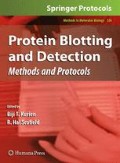Summary
The reversible phosphorylation of phosphoproteins is a vital regulatory process for many cellular pathways. A reliable and simple fluorescent detection technique for phosphoproteins has been developed using a small-molecule organic fluorophore, Pro-Q Diamond dye. This was originally developed for use in gel staining, but a new formulation has allowed for its use in protein blotting. The dye binds noncovalently and selectively to the phosphate moiety, so proteins lacking phosphate groups and other macromolecules such as DNA or RNA are not detected. It uses a standard electrophoresis and electroblotting technique, which can blot the sample onto nitrocellulose membranes or polyvinylidene fluoride (PVDF). The electroblotting is followed by staining with the dye and destaining. The blot can then be read by multiple types of imaging devices such as a laser-based gel scanner. This process is compatible with matrix-assisted laser desorption time-of-flight mass spectrometry (MALDI-TOF-MS) and Edman sequencing. It can also be followed by standard chemiluminescent, colorimetric, and fluorogenic detection techniques used in immunoblotting.
Access this chapter
Tax calculation will be finalised at checkout
Purchases are for personal use only
References
Hunter, T. (1995) Protein kinases and phosphatases: the yin and yang of protein phosphorylation and signaling. Cell 80, 225–236.
Zolnierowicz, S. and Bollem, M. (2000) Protein phosphorylation and protein phosphatases. EMBO J 19, 483–488.
Sickmann, A. and Meyer, H.E. (2001) Phosphoamino acid analysis. Proteomics 1, 200–206.
Wettenhall, R.E., Aebersold, R.H., and Hood, L.E. (1991) Solid-phase sequencing of 32P-labeled phosphopeptides at picomole and subpicomole levels. Methods Enzymol 201, 186–199.
Yeargin, J. and Haas, M. (1995) Elevated levels of wild-type p53 induced by radiolabeling of cells leads to apoptosis or sustained growth arrest. Curr Biol 5, 423–431.
Towbin, H., Staehelin, T., and Gordon, J. (1979) Electrophoretic transfer of proteins from polyacrylamide gels to nitrocellulose sheets: procedure and some applications. Proc Natl Acad Sci USA 76, 4350–4354.
Kaufmann, H., Bailey, J.E., and Fussenegger, M. (2001) Use of antibodies for detection of phosphorylated proteins separated by two-dimensional gel electrophoresis. Proteomics 1, 194–199.
Schulenberg, B., Aggeler, R., Beechem, J.M., Capaldi, R.A., and Patton, W.F. (2003) Analysis of steady-state protein phosphorylation in mitochondria using a novel fluorescent phosphosensor dye. J Biol Chem 278, 27251–27255.
Goodman, T., Schulenberg, B., Steinberg, T.H., and Patton, W.F. (2004) Detection of phosphoproteins on electroblot membranes using a small-molecule organic fluorophore. Electrophoresis 25, 2533–2538.
Laemmli, U.K. (1970) Cleavage of structural proteins during assembly of the head of bacteriophage T4. Nature 227, 680–685.
Acknowledgments
This work was supported by NIH grant ARO1844 and Oklahoma Center for the Advancement of Science and Technology to RHS.
Author information
Authors and Affiliations
Corresponding author
Editor information
Editors and Affiliations
Rights and permissions
Copyright information
© 2009 Humana Press, a part of Springer Science+Business Media, LLC
About this protocol
Cite this protocol
Bockus, L.B., Scofield, R.H. (2009). Phosphoprotein Detection on Protein Electroblot Using a Phosphate-Specific Fluorophore. In: Kurien, B., Scofield, R. (eds) Protein Blotting and Detection. Methods in Molecular Biology, vol 536. Humana Press, Totowa, NJ. https://doi.org/10.1007/978-1-59745-542-8_39
Download citation
DOI: https://doi.org/10.1007/978-1-59745-542-8_39
Published:
Publisher Name: Humana Press, Totowa, NJ
Print ISBN: 978-1-934115-73-2
Online ISBN: 978-1-59745-542-8
eBook Packages: Springer Protocols

